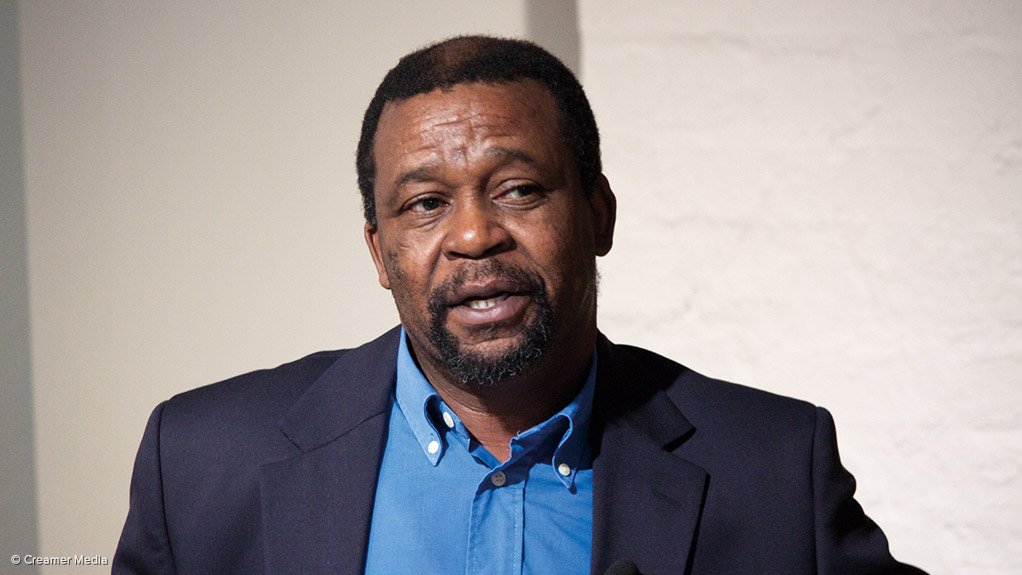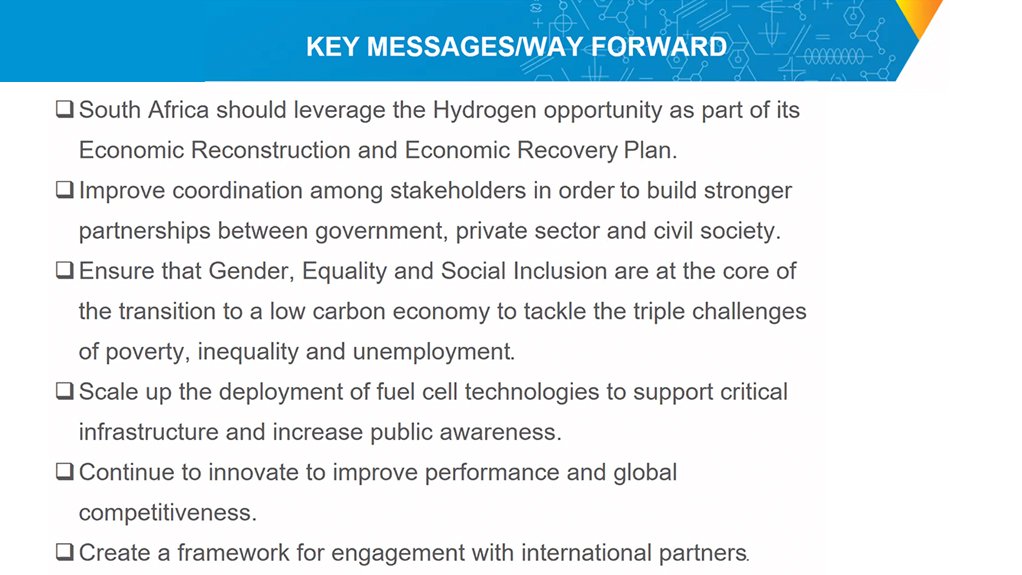JOHANNESBURG (miningweekly.com) – South Africa should leverage the hydrogen opportunity as part of its official economic reconstruction and economic recovery plan.
Dr Cosmas Chiteme, the director of hydrogen and energy at the Department of Science and Innovation, highlighted this as the top key message on the way forward at the conclusion of his address to the seventh Platinum Group Metal (PGM) Roundtable, hosted by South Africa’s Mapungubwe Institute for Strategic Reflection (Mistra). (Also watch attached Creamer Media video.)
“What is key is to improve coordination among stakeholders. In that regard, we are proposing a coordination structure at a very high level in government as part of our update to Cabinet in the next few weeks,” Chiteme told the online event covered by Mining Weekly.
That particular structure is also expected to advance the process to a point where it can transition to being a permanent structure that is being considered in collaboration with the United Nations Industrial Development Organisation, also known as Unido.
“Recently, we have seen that a number of partners are coming to South Africa and, in some cases, that has also highlighted the gaps that we have across government in terms of coordination, but this is what we hope to address with that proposed structure that we are taking to Cabinet,” said Chiteme.
The theme of the event was exploring opportunities within the PGMs sector to support a just transition to a climate-resilient and sustainable South African society.
Disclosed during question time was that South Africa will have a stand at the fuel cell expo scheduled to place in Tokyo in March 2023, where South Africa's private sector will also be participating
In addition, green hydrogen and green ammonia collaboration has been initiated with Germany and Japan, and locally, fuel cell power is to be introduced along Malibongwe Drive, northwest of Johannesburg, to alleviate major traffic congestion.
There will also be continued deployment of fuel cell systems in schools, clinics, government facilities and increased engagement with local authorities as an advance towards 10 kW systems is progressed.
“A few years ago, our focus was largely on fuel cell technology and PGM beneficiation. Now a wide array of issues is coming to the fore, including the production, domestic use and export of green hydrogen, feedstock for industrial processes, and energy sources for industrial and domestic use,” Mistra executive director Joel Netshitenzhe said as he emphasised the multiple uses of green hydrogen.
“Two issues also stand out for continuing reflection. The first is about the statutory platform to facilitate the emergent industry. As a major centre in the value chain of fuel cell technology and green hydrogen, South Africa will indeed have to be among global first movers in ensuring that hydrogen applications are harmonised, safe and interoperable through both hard and soft regulatory mechanisms,” said Netshitenzhe.
“The second issue is about skills development. It is estimated that across the spatial dimension in the Platinum Valley and the Saldanha and Boegoebaai hubs as well the sectoral applications in mining, steel production and electricity generation, some 20 000 jobs can be created in the hydrogen economy by 2030,” he added.
These jobs would range from science, technology and innovation to artisanship services, which demanded that training in all related areas needed to be systematically pursued and the extensive experiences that South Africa had garnered over the years built on.
Cooperation with educational institutions, equipment manufacturers, and State parties across the globe needed to be strengthened.
“In the bold programme of the Department of Science and Innovation to convert large numbers of buses, trucks and forklifts to green hydrogen by 2025, in the programme to promote domestic fuel cell and hydrogen demand and in the initiatives to ensure localisation in fuel cell manufacturing, let us not find ourselves constrained by a skills deficit that we can more intently start addressing today,” added Netshitenzhe.
SECURITY OF PGM SUPPLY
This year, the science agents of the United States' Department of Interior placed PGMs among commodities critical to its economy and national security and flagged supply risks as an area requiring attention.
A few months ago, when the Shanghai platinum and precious metals centre was initiated, companies were encouraged to secure long-term PGM supplies.
As such, given South Africa’s large PGM endowments, the country had a responsibility to ensure security of supply, which would, Netshitenzhe said, require social compacting between mining companies, workers and communities.
HYDROGEN SOCIETY ROADMAP
Higher Education Minister Dr Blade Nzimande, who led a delegation to Japan last month, in February officially released South Africa’s Hydrogen Society Roadmap, which is tied to South Africa’s 2050 net-zero ambition.
The six high-level outcomes identified in the roadmap involve greening the power sector with stationary fuel cell applications, decarbonising transport by focusing on heavy duty trucks in the short to medium term, creating a manufacturing sector for hydrogen components, greening energy-intensive, hard-to-abate sectors by replacing grey hydrogen with green hydrogen, establishing green hydrogen and green ammonia as an export commodities, and responsibly transitioning from blue to green hydrogen.
“It’s time for us to get on with the work,” said Chiteme.
EMAIL THIS ARTICLE SAVE THIS ARTICLE ARTICLE ENQUIRY
To subscribe email subscriptions@creamermedia.co.za or click here
To advertise email advertising@creamermedia.co.za or click here














